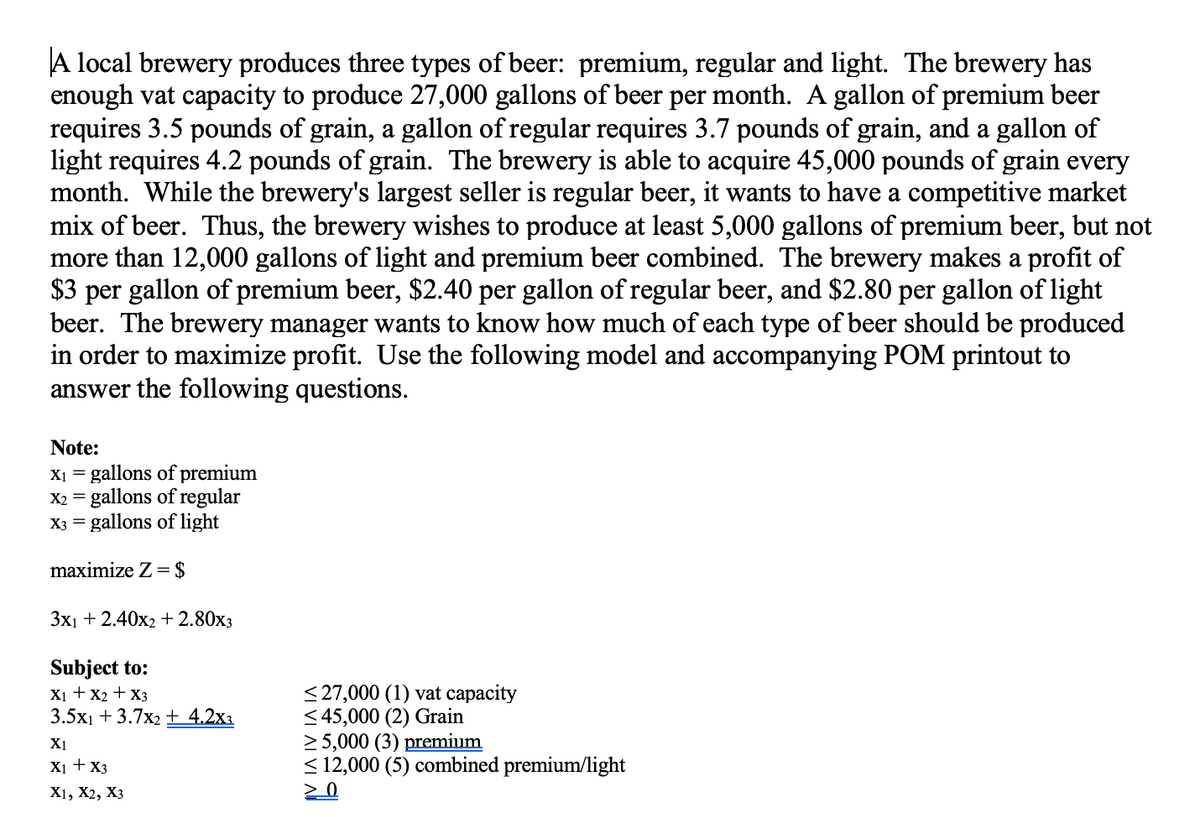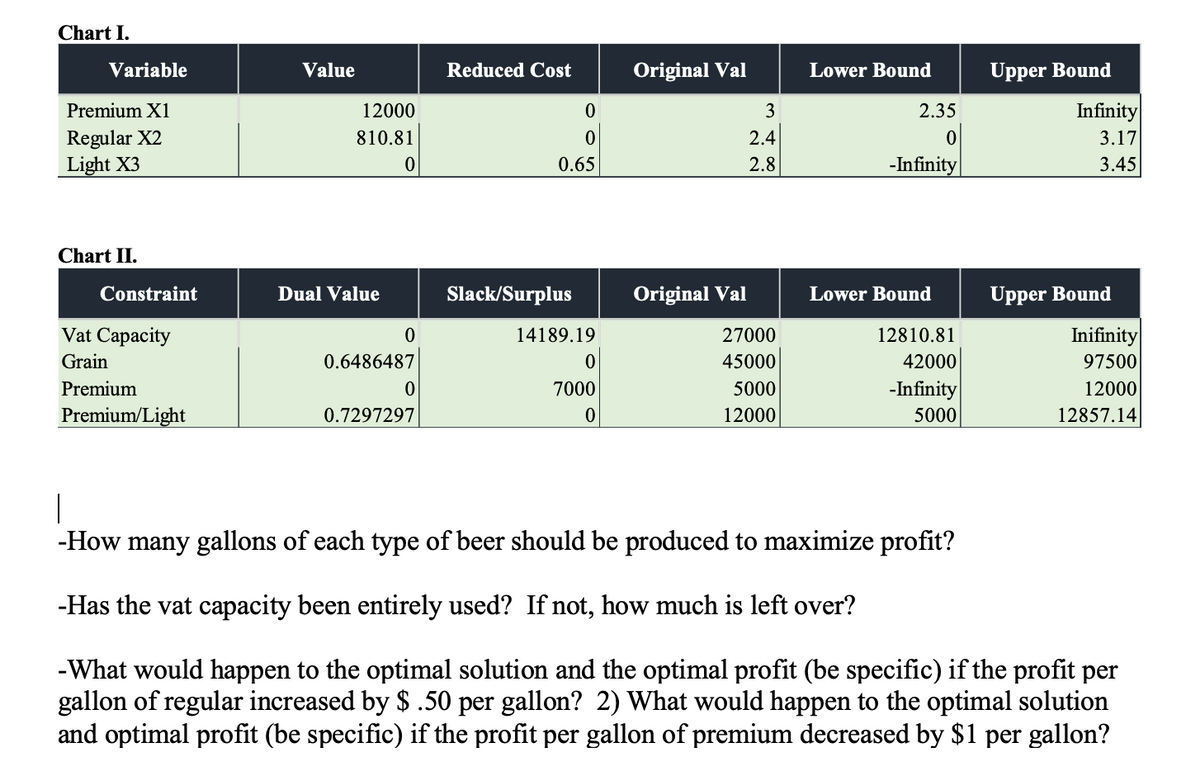A local brewery produces three types of beer: premium, regular and light. The brewery has enough vat capacity to produce 27,000 gallons of beer per month. A gallon of premium beer requires 3.5 pounds of grain, a gallon of regular requires 3.7 pounds of grain, and a gallon of light requires 4.2 pounds of grain. The brewery is able to acquire 45,000 pounds of grain every month. While the brewery's largest seller is regular beer, it wants to have a competitive market mix of beer. Thus, the brewery wishes to produce at least 5,000 gallons of premium beer, but no more than 12,000 gallons of light and premium beer combined. The brewery makes a profit of $3 per gallon of premium beer, $2.40 per gallon of regular beer, and $2.80 per gallon of light beer. The brewery manager wants to know how much of each type of beer should be produced in order to maximize profit. Use the following model and accompanying POM printout to answer the following questions.
A local brewery produces three types of beer: premium, regular and light. The brewery has enough vat capacity to produce 27,000 gallons of beer per month. A gallon of premium beer requires 3.5 pounds of grain, a gallon of regular requires 3.7 pounds of grain, and a gallon of light requires 4.2 pounds of grain. The brewery is able to acquire 45,000 pounds of grain every month. While the brewery's largest seller is regular beer, it wants to have a competitive market mix of beer. Thus, the brewery wishes to produce at least 5,000 gallons of premium beer, but no more than 12,000 gallons of light and premium beer combined. The brewery makes a profit of $3 per gallon of premium beer, $2.40 per gallon of regular beer, and $2.80 per gallon of light beer. The brewery manager wants to know how much of each type of beer should be produced in order to maximize profit. Use the following model and accompanying POM printout to answer the following questions.
Practical Management Science
6th Edition
ISBN:9781337406659
Author:WINSTON, Wayne L.
Publisher:WINSTON, Wayne L.
Chapter4: Linear Programming Models
Section: Chapter Questions
Problem 107P
Related questions
Question

Transcribed Image Text:A local brewery produces three types of beer: premium, regular and light. The brewery has
enough vat capacity to produce 27,000 gallons of beer per month. A gallon of premium beer
requires 3.5 pounds of grain, a gallon of regular requires 3.7 pounds of grain, and a gallon of
light requires 4.2 pounds of grain. The brewery is able to acquire 45,000 pounds of grain every
month. While the brewery's largest seller is regular beer, it wants to have a competitive market
mix of beer. Thus, the brewery wishes to produce at least 5,000 gallons of premium beer, but not
more than 12,000 gallons of light and premium beer combined. The brewery makes a profit of
$3 per gallon of premium beer, $2.40 per gallon of regular beer, and $2.80 per gallon of light
beer. The brewery manager wants to know how much of each type of beer should be produced
in order to maximize profit. Use the following model and accompanying POM printout to
answer the following questions.
Note:
X1 = gallons of premium
X2 = gallons of regular
X3 = gallons of light
maximize Z = $
Зх1 + 2.40х2 + 2.80хз
Subject to:
X1 + x2 + X3
3.5x1 + 3.7x2 + 4.2xa
< 27,000 (1) vat capacity
< 45,000 (2) Grain
2 5,000 (3) premium
< 12,000 (5) combined premium/light
X1
X1 +X3
X1, X2, Хз

Transcribed Image Text:Chart I.
Variable
Value
Reduced Cost
Original Val
Lower Bound
Upper Bound
Premium X1
12000
3
2.35
Infinity
Regular X2
Light X3
810.81
2.4
3.17
0.65
2.8
-Infinity|
3.45
Chart II.
Constraint
Dual Value
Slack/Surplus
Original Val
Lower Bound
Upper Bound
Vat Capacity
14189.19
27000
12810.81
Inifinity
Grain
0.6486487
45000
42000
97500
Premium
7000
5000
-Infinity
12000
Premium/Light
0.7297297
12000
5000
12857.14
-How many gallons of each type of beer should be produced to maximize profit?
-Has the vat capacity been entirely used? If not, how much is left over?
-What would happen to the optimal solution and the optimal profit (be specific) if the profit per
gallon of regular increased by $ .50 per gallon? 2) What would happen to the optimal solution
and optimal profit (be specific) if the profit per gallon of premium decreased by $1 per gallon?
Expert Solution
This question has been solved!
Explore an expertly crafted, step-by-step solution for a thorough understanding of key concepts.
This is a popular solution!
Trending now
This is a popular solution!
Step by step
Solved in 3 steps

Knowledge Booster
Learn more about
Need a deep-dive on the concept behind this application? Look no further. Learn more about this topic, operations-management and related others by exploring similar questions and additional content below.Recommended textbooks for you

Practical Management Science
Operations Management
ISBN:
9781337406659
Author:
WINSTON, Wayne L.
Publisher:
Cengage,

Practical Management Science
Operations Management
ISBN:
9781337406659
Author:
WINSTON, Wayne L.
Publisher:
Cengage,